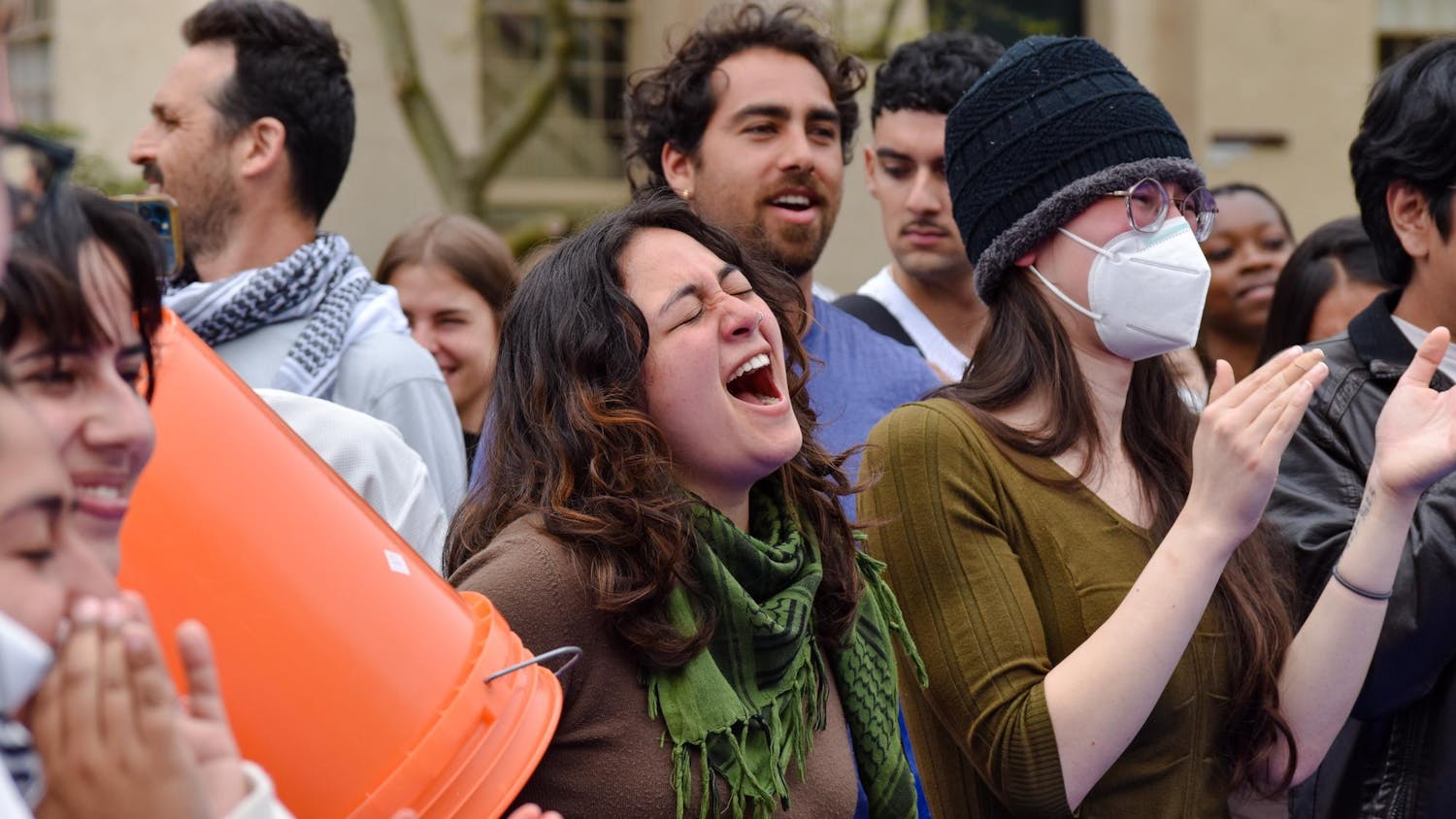In President Ruth Simmons' living room hangs a painting of Paradise Pond, a lake in the center of the Smith College campus. Simmons said it reminds her of a house where she once lived — a great white structure that looked out over the lake.
"There were beautiful gardens," she said, "and lovely places to walk in."
Elsewhere in her home hangs an artistic rendering of a campus center whose conception she initiated at Smith. Today, the center's steps are inscribed with the words, "To Ruth Simmons, who built bridges of understanding." She still has scrapbooks brimming with photos and mementos of special events that occurred on campus, including a barbecue held in her honor.
The objects were all parting gifts from faculty, administrators and students at the college she once called home. Before Simmons arrived on College Hill in 2001, she was president of Smith — the largest women's college in the country — for six years.
When she accepted her position as president of Smith, Simmons became the first black woman to lead a major college or university. While there, she doubled the endowment and helped create the first engineering school at a women's college .
The launching of an engineering school presented its difficulties. "Initially, there was no space, so we put up a temporary building — a trailer," Simmons said. Over time, she convinced more donors to fund her "radical idea" for an engineering school, and the Picker Engineering Program was born.
Simmons has fond memories of Smith's campus traditions and culture, several of which involved nude student processions around campus, she said. She was once entertaining a donor at her house when the doorbell rang. She opened the door to find a group of naked women. Though Simmons was concerned about her guest's response, she said the donor, an elderly woman, actually found it "hilarious" and proceeded to pledge money to the college.
Another time, students who were Christmas caroling brought a horse into her house.
Smith students are "great practical jokers with incredible traditions that are usually noisy," she said with a laugh. Despite Smith's close proximity to Providence — its campus lies about 100 miles to the northwest — Simmons said she has not been able to visit often during her tenure at Brown because of her busy schedule. She also expressed a desire to avoid "lurking around" or "hovering" over the president who succeeded her. But she has maintained contact with many friends there, she said.
Fearless leadership
Faculty members and administrators at Smith remember Simmons as an innovative leader.
"Ruth always stood out as someone who was thinking very carefully, clearly, freshly," said Elizabeth Spelman, chair of the philosophy department at Smith and member of the search committee that brought Simmons to the school.
"I'm not suggesting she walked on water," she said. "I'm sure people had disappointments and frustrations." But overall, Spelman said, "there was an overwhelming enthusiasm about her."
John Connolly, professor of philosophy and provost at Smith during Simmons' presidency, said she achieved a lot in a short space of time. She responded to the need for a non-residence-oriented social meeting place with the construction of the campus center and encouraged women to pursue the sciences with the engineering program, he said.
Simmons had "a rejuvenating effect on the college," he said. Though she started her presidency at a time of budgetary problems, "she didn't want to tighten belts. She wanted to see Smith excelling in its historical way, marching off into new directions," he said.
Simmons was "a very demanding boss," he added. "She pushed us all very hard — and I don't imagine that stopped when she went to Brown."
Connolly said Simmons' presidency was a time of "living high" and great expenditures on new proposals, but after she left, the recession of 2001 and the events of Sept. 11 left the college struggling with its endowment.
"There was some grumbling about how she had great ideas, but now she leaves, and we're stuck with the bill," he said. Though Simmons had held discussions about cuts to make in the event of a stock market decline, she was not available to lead the college through the "painful task of contracting again," he said, "People were grumbling about that."
Karl Donfried, professor emeritus of religion at Smith, said Simmons ranks among the institution's best presidents. He remembers her as an effective fundraiser. "She never said that we can't do something because of money — if it seemed like a good idea, she'd get the contracts," he said.
Paula Giddings, professor of Afro-American studies at Smith, lauded Simmons' establishment of the Kahn Liberal Arts Institute, a program that brings together faculty, students and specialists for interdisciplinary seminars. Simmons also introduced a peer review journal by and about women of color and initiated programs that allowed poorer students to attend Smith, Giddings said.
Giddings also pointed to Simmons' inspirational presence. "People have faith that she will do something good for the institution and something good for you, too," she said.
‘Rockstar' presence
To Smith students, Simmons was a mentor, an adviser and a friend.
Laura Crimaldi, who graduated from Smith in 2001, became acquainted with the president when Simmons' daughter's cat found its way into her backyard. As a thank-you gesture for returning the cat, Crimaldi and her housemates were invited to dine at Simmons' home.
She said she still remembers sitting in Simmons' living room, drinking cranberry juice and looking through a coffee table book with an inscription from Oprah Winfrey.
On the day before her final commencement at Smith in 2001, Simmons broke down crying during a speech to students, Crimaldi said. "Everyone was yelling out, ‘We love you, Ruth!'"
"But no one made T-shirts — that's just a Brown thing," she added.
"It was like being on campus with a rockstar," said Jennifer Daigle-Matos, who graduated from Smith in 1996.
At the same time, students appreciated the casual way they could interact with Simmons.
Matos said she was once at a candlelight vigil against racist comments on campus when she turned around and saw Simmons standing behind her with a candle. Simmons was also known to call students by their first names across the quad and dance with seniors at the ball, she said.
Students once rioted outside Simmons' house calling for a Mountain Day, a Smith tradition in which the president cancels classes for the day so students can enjoy the weather.
Simmons came outside in her pajamas, smiled, waved and politely asked students to be quiet for her guests, said Jessica Mele, a mem
ber of the Smith class of 2001. "There was a collective ‘Sorry!' from about 700 students gathered in her driveway," Mele wrote in an email to The Herald.
"She was transformative," said Ileana Jimenez, a 1997 Smith graduate who spoke to Simmons about career advice. "I feel bad for anyone coming after her."
A breadth of experiences
Simmons said she has enjoyed every college and university where she has worked.
Before Simmons arrived at Smith, she was an administrator at Princeton. She said it was administrators there who first gave her the idea of becoming a college president.
"I've seen a little bit of everything," she said, pointing out that she has worked at women's colleges, historically black colleges and Ivy League universities.
"Her biggest legacy is her devotion to excellence and education and faculty," said Peter Rose, professor of sociology and anthropology emeritus at Smith.
When Simmons left Smith, Rose said he wrote her a poem which ended with the line, "She's gone to Brown and now we're all blue."
Connolly, who served as Smith's interim president after Simmons' departure, said he understood Brown students' sorrow over Ruth stepping down. "We went through it, too," he said.
— With additional reporting by Mathias Heller




